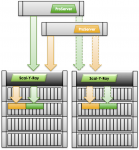The only way to build a datacenter with flexibility and scale is automation. And this is as true for networks and servers as it is for storage. IT architects increasingly design integrated and automated systems, not static interconnects. They must learn scripting and look for solutions that are responsive to changing demand. And they have to start getting excited about companies playing in this space.
Virtual Storage
Top VMware Blogs 2014: How I Voted
Once again, it’s time for vSphere-Land.com’s “Top vBlog” voting. And once again Feedbin and Twitter are full of hundreds of bloggers lamely begging for me to vote for them. And once again, I didn’t base my votes on their begs or my own hunches. Follow along as I explain how I actually voted and why I think you should use the same mechanism. And no, I’m not going to say who I voted for!
Making a Case For (and Against) Software-Defined Storage
Everyone is talking about “software-defined†everything lately, so it was only a matter of time before industry buzz turned to software-defined storage. VMware and EMC really stoked the flames with a constant barrage of marketing directed in this direction. But how exactly do you software-define storage? And what does this mean?
Scaling Storage At The Client
Scaling storage is a serious challenge for the industry, but there is a great deal of thought, effort, and creativity going into it right now. Companies like Gridstore, Oxygen Cloud, and Cleversafe have come up with effective client-side solutions to enable scale-out storage to sing. If you’ve got an appropriate application, client, or gateway, scale-out is a real possibility!
Scaling Storage In Conventional Arrays
It is amazing that something as simple-sounding as making an array get bigger can be so complex, yet scaling storage is notoriously difficult. Our storage protocols just weren’t designed with scaling in mind, and they lack the flexibility needed to dynamically address multiple nodes. So my hat is off to these companies and others who have come up with clever ways to maintain compatibility while scaling out beyond the bounds of a single storage array.




